This is the seventh in a continuing series of my (very unofficial) trip reports about my travels in Eastern Europe. Those of you who have read the other six Postcard Diaries know that I work as an International Trade Specialist for an Agency of the U.S. Government. My area of specialty is Eastern Europe, and for the previous few Postcard Diaries my travels were related to an international trade promotion-related initiative (which I originated) in support of small business. That initiative is over now; it was not really successful enough in making things happen to continue, but it did get me involved in an equally interesting area, of market liberalizations in the energy-sector. Anyway, when I first started writing these Diaries back in 1997, it used to be hard to keep in touch with the outside world, but with the proliferation of public-access Internet cafés over there, that's not really true any more. Even a telephone calling car gives you, for about five dollars, about five minutes of telephone time to home. A Postcard Diary isn't necessary anymore to stay in contact with home, but it's still is a good way of preserving memories. The way it works is that whenever I'm on extended travel, I send one postcard back home every day, trying to pack as much information on it as possible I want each one to be not only a stand-alone essay, but also a chapter of an overall larger diary of that trip that would give any readers of the collection a vicarious experience of what it's like to work and travel in Eastern Europe. There was a challenge: be interesting, be entertaining, but above all, be brief! Often not easy, but most every day I was able to find one or two things interesting enough to build a short essay around, even if after a long day, composing that essay wasn't something that I always looked forward to.
Anyway, after reading through this new assembled collection of cards, I've once again added some comments between the postcards for continuity and transition, and to expand on some things where just wasn't enough room in a postcard. As always, I hope you enjoy reading these essays.
I think the biggest problem I had with the A340 was that it got unpleasantly warm and stuffy because there weren't any little air-blower vents like the older airplanes have. The personal video screen was nice (when it worked), but I mostly just listened to music -- the one movie I tried to watch, Traffic, cut out about two-thirds of the way through it. There were a few other annoyances to deal with even after I got to Prague -- I'd switched to a slightly larger suitcase just before I left home, and in the rush I'd missed transferring over my neckties and spare socks. This led to a rather hurried look around for a mens clothing store late in the afternoon. It was much easier to find places that sold, for instance, fine Bohemian crystal. But you can't wear that stuff on your feet!
Most of the taxi drivers in Prague know some English, apparently. When I asked him, "Can you get me
there in a hurry?" his face lit up like I'd said the magic words. "No Problem!" he said, and the chase was
on. Anyway, it turned out that all my business meetings during my time in Prague were on that one day.
There was supposed to be a meeting the next day, but it was canceled when I couldn't find an affordable
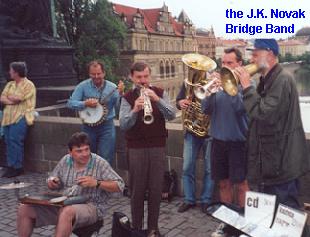 (read: 'free') translator. But I wasn't all that disappointed -- my compressed work schedule (nine-hour
work days) gives me every other Friday as a scheduled day off. And that's the way it worked out!
(read: 'free') translator. But I wasn't all that disappointed -- my compressed work schedule (nine-hour
work days) gives me every other Friday as a scheduled day off. And that's the way it worked out!
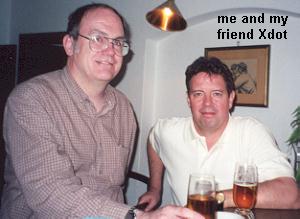 I thought it was kind of ironic that my university professor friend was in the U.S.A. while I was in
Prague, but on the other hand, one of my friends from the U.S.A. was in Prague while I was there. (Talk
about a small world!) Tim Perry, a.k.a. Xdot the poker-playing statistician, who was in town for a
wedding. Events surrounding the wedding filled most of his available time, though, and there was only
one evening where we were able to meet for a few beers. I asked him how he was enjoying his first trip
to Prague, and he answered by saying it was his first visit, but wouldn't be his last. I think that, back in
1990 on my first visit there, I said the same thing. It's a great city.
I thought it was kind of ironic that my university professor friend was in the U.S.A. while I was in
Prague, but on the other hand, one of my friends from the U.S.A. was in Prague while I was there. (Talk
about a small world!) Tim Perry, a.k.a. Xdot the poker-playing statistician, who was in town for a
wedding. Events surrounding the wedding filled most of his available time, though, and there was only
one evening where we were able to meet for a few beers. I asked him how he was enjoying his first trip
to Prague, and he answered by saying it was his first visit, but wouldn't be his last. I think that, back in
1990 on my first visit there, I said the same thing. It's a great city.
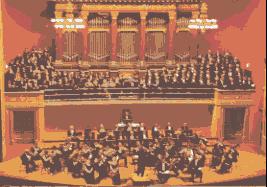 It's my last day in Prague and the highlight of the day was the evening concert, my first classical music
event of the trip. There are a lot of nightly music events here -- I counted more than 20 different flyers at
one of the information kiosks (and that doesn't even include all the piano bars and jazz clubs). The
concert I went to was the biggest one of the night -- a full orchestra and chorale rendition of Carl Orff's
Carmina Burana. It was stunning -- full of sound and fury, at times a delicate thing and at other times a
beast. I've decided that I like chorale works. Will opera be next?
It's my last day in Prague and the highlight of the day was the evening concert, my first classical music
event of the trip. There are a lot of nightly music events here -- I counted more than 20 different flyers at
one of the information kiosks (and that doesn't even include all the piano bars and jazz clubs). The
concert I went to was the biggest one of the night -- a full orchestra and chorale rendition of Carl Orff's
Carmina Burana. It was stunning -- full of sound and fury, at times a delicate thing and at other times a
beast. I've decided that I like chorale works. Will opera be next?I should mention that the concert also included a fine performance of Felix Mendelssohn's 4th ("Italian")
Symphony, which made the evening well worth the 850 Czech crowns (about US$22.50) it cost for
admission. The event was very well attended; the concert hall (which seated maybe 2,000) looked to be
about three-quarters filled. Almost all of these were foreigners like me, of course -- from more affluent
places like Western Europe, Japan, and the United States. The Czech crown, like other Eastern European
currencies, has a low value vs. the U.S. dollar and other western currencies, and this makes Prague a real
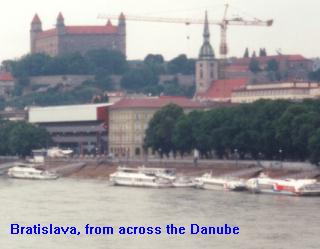 bargain for those of us from Western Europe, Japan, and the U.S.A. -- there are now thousands and
thousands of tourists in Prague and I was hearing English on the streets more often than I was hearing
Czech. So all of those concerts each night are not intended for the locals; by Czech standards they are
prohibitively expensive, as are most of the hotels in the city. Prague, for all its splendor, is not the real
Czech Republic -- it's become a cash cow that helps to drive the country's economy.
bargain for those of us from Western Europe, Japan, and the U.S.A. -- there are now thousands and
thousands of tourists in Prague and I was hearing English on the streets more often than I was hearing
Czech. So all of those concerts each night are not intended for the locals; by Czech standards they are
prohibitively expensive, as are most of the hotels in the city. Prague, for all its splendor, is not the real
Czech Republic -- it's become a cash cow that helps to drive the country's economy.
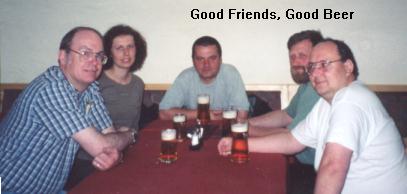 discovered Bratislava yet. But my stay here in Bratislava this time will be so short that the traditional pub
crawl my friends here plan for the end of my business trips here will be tomorrow night!
discovered Bratislava yet. But my stay here in Bratislava this time will be so short that the traditional pub
crawl my friends here plan for the end of my business trips here will be tomorrow night!The pub crawl was also a bit low key this year. I was able to limit myself to about a liter-and-a-half of beer, and managed to get back to the Pension where I was staying by about 10:30pm. Still, it was a lot of fun -- good food, good beer, good conversation with good friends. It's one of the things that I look forward to each time I come to Slovakia.
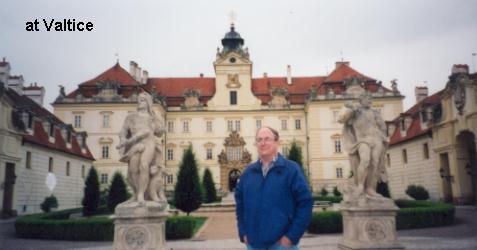 Monday, June 11, 2001 (Bratislava)
Monday, June 11, 2001 (Bratislava)The very photogenic castle at Lednice was home to a regional history/natural history museum that
included everything from medieval weaponry to preserved specimens of practically every mammal, bird,
reptile, fish, and insect that was native to the area. There was even an aquarium that had live specimens
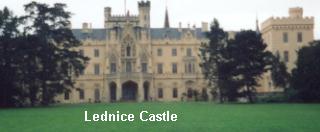 of many tropical salt water fish -- hopefully not in anticipation that the Czech Republic would someday
have a global warming-induced coastline! The Valtice castle was even more picturesque, but
unfortunately, it was closed on Mondays. Valtice was also the location of a Wine Academy, though not
at the castle. The curriculum there probably wasn't the most difficult of the Czech Republic's colleges
and universities, but I'll bet it was probably the most fun!
of many tropical salt water fish -- hopefully not in anticipation that the Czech Republic would someday
have a global warming-induced coastline! The Valtice castle was even more picturesque, but
unfortunately, it was closed on Mondays. Valtice was also the location of a Wine Academy, though not
at the castle. The curriculum there probably wasn't the most difficult of the Czech Republic's colleges
and universities, but I'll bet it was probably the most fun!
I happened across a much more modern performance that evening in the Old Town Square a laser light show that painted colorful, intricate, and very short-lived designs on the wall of the city museum. Apparently this had been going on nightly for several weeks -- a brief performance each hour, sundown to midnight. It was fascinating, and also typical for Bratislava nowadays -- the modern superimposed over the old.
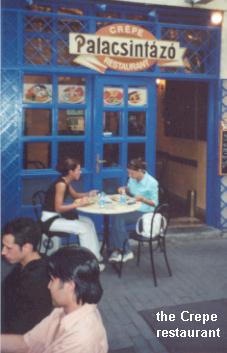 Wednesday, June 13, 2001 (Budapest, Hungary)
Wednesday, June 13, 2001 (Budapest, Hungary)If you want to get technical about it, the Mozart composition was a Simfonia Concertante designated K364. The young violist's name was Anna Szász, who I was told was the daughter of one of Hungary's premiere violinists. Obviously, musical talent runs in the family! Even though the recital wasn't publicized very well, there were still a couple hundred people there in the concert hall. And it was free! As for the restaurant, dinner, beverage, and dessert (a chocolate ice cream-filled crepe with vanilla sauce and whipped cream, yum!) came to just under US$5 for the entire meal. Is it a great country, or what?
When I explained to Greg what it meant to be Baconizable*, he just laughed. He described Brad Pitt as
mostly a regular guy, and the one scene he had with him took about ten takes and a half day to shoot (he
was even given a trailer on the set for that half day). But you don't become rich by being a bit player; his
half day of movie acting made him about US$400, which he donated to a battered women's shelter in
Budapest.
![]()
* OK, in case you're wondering, here's how the 'Six Degrees of Kevin Bacon Game' works: Greg is in Spy Game along with Brad
Pitt; Brad Pitt was in Sleepers along with Kevin Bacon. So, unless his scene winds up on the cutting room floor,
Greg's 'Bacon Number' will be '2'.
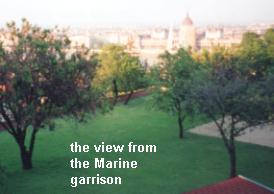 Friday, June 15, 2001 (Budapest)
Friday, June 15, 2001 (Budapest)I should mention that Chaumont, N.Y., with a population of maybe 500, is where I lived from early
childhood until I graduated from high school (it's about 15 miles west of Watertown, N.Y., on the shore
of Lake Ontario in Jefferson County, N.Y., in case you want to look it up on a road map). It was
absolutely mind boggling that I should meet somebody who was so familiar with that little village and its
region -- even more so that it would be somebody I'd met in Budapest, Hungary. Anyway, the place
where the party was held was the U.S. Marines garrison in Budapest (the Marines provide security at all
U.S. Embassies around the world), a mini-compound with its own barracks and clubroom, as well as a
nice view down to the Danube River, right across from the Hungarian parliament building. Part of the
compound has some historical significance to Hungary it's the 'Powder House', an old jail where, back
in the mid 19th century, Lajos Kossuth, the father of Hungarian Revolution against the Austro-Hungarian
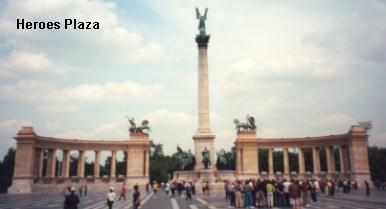 Empire, was imprisoned. There's an open house each Halloween where they use the Powder House as a
haunted house. Supposedly it's pretty eerie down in there.
Empire, was imprisoned. There's an open house each Halloween where they use the Powder House as a
haunted house. Supposedly it's pretty eerie down in there.
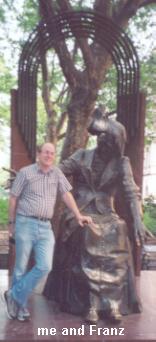 Saturday, June 16, 2001 (Budapest)
Saturday, June 16, 2001 (Budapest)I'd been up and down Andrassy Street many times previously, but never above ground. One of
Budapest's three subway lines goes right up Andrassy, and all the times I'd ridden it, I'd had no idea
what things were like just a few meters above my head. Just beyond the Heroes Plaza is the City Park,
probably the largest green area in Budapest. It has a very large thermal bath, housed in an impressively
large and ornate building, and a castle that's been turned into the National Agricultural Museum.
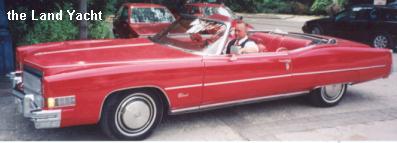 Actually, there's more at the castle than just the museum -- there's also a small cathedral that's apparently
very popular for weddings. There was one going on when I passed through there that day; the bride and
groom had just emerged and were being surrounded by all their invited well-wishers, and right across the
street awaited their hired transportation to take them off somewhere. Nope, not a horse-drawn carriage --
it was a cherry red 1959 Cadillac El Dorado convertible, big as a yacht and just as impressive. As in the
U.S.A., size does matter, apparently!
Actually, there's more at the castle than just the museum -- there's also a small cathedral that's apparently
very popular for weddings. There was one going on when I passed through there that day; the bride and
groom had just emerged and were being surrounded by all their invited well-wishers, and right across the
street awaited their hired transportation to take them off somewhere. Nope, not a horse-drawn carriage --
it was a cherry red 1959 Cadillac El Dorado convertible, big as a yacht and just as impressive. As in the
U.S.A., size does matter, apparently!
Well, it's not actually all that bad -- Poland is still a pretty good bargain, though the other three countries I visited, especially Slovakia, were less expensive yet. The things I most noticed higher prices for were watercolors and other art (I collect interesting buildings, or at least drawings, watercolors, and lithographs of them) and restaurant food; perhaps not coincidentally, both of these were in the Old Town Square, which was crawling with tourists. On a walk through the Square with a friend looking at the artwork, we had to run for cover when the biggest thunderstorm I've ever experienced in Poland blew through. It was almost a relief to find that the prices weren't the only thing that's become larger since my last trip to Poland!
I'm glad the coin-scattering didn't happen at my favorite amber jewelry shop. I usually spend a few
hundred zloties there every time I'm in Warsaw. I hadn't been to that store since my last visit to
Warsaw, a year earlier, but just as in Budapest I was recognized the second I walked in there. It was
even more remarkable than Budapest, actually, because the store owners were in the middle of an
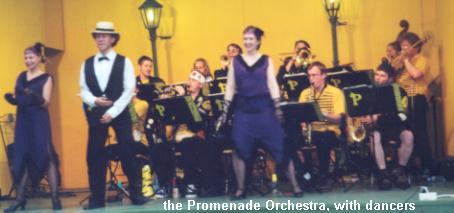 amber-buying feeding frenzy by a small mob of Italian tourists. It was a good half hour before the
crowd thinned enough where I could even begin looking for pieces to buy.
amber-buying feeding frenzy by a small mob of Italian tourists. It was a good half hour before the
crowd thinned enough where I could even begin looking for pieces to buy.